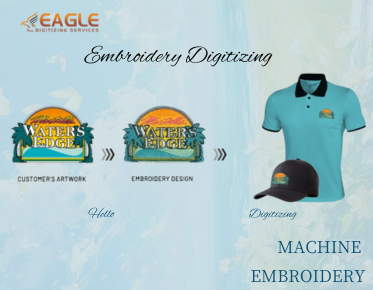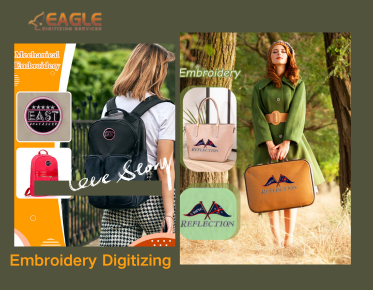Screen Printing Methods Explained: Find Your Style from Eagle Digitizing
Screen printing, a versatile and vibrant art form, has evolved significantly over the centuries. From its humble beginnings to the sophisticated techniques used today, screen printing continues to captivate artists, designers, and businesses alike. For the top-notch online vector conversion, don't hesitate to get in touch with us.
Why Screen Printing is Popular Today
Screen printing is favored due to its versatility and cost-effectiveness for large batches. It's widely used in the textile industry, advertising, and even fine art. The ability to produce vibrant, long-lasting prints on various materials keeps screen printing relevant in an ever-changing market. Its adaptability and the potential for high detail and durability make it a go-to method for many applications.
Traditional Screen Printing
Basics of Traditional Screen Printing
Traditional screen printing entails producing a stencil (or screen) and utilizing it to apply layers of ink to the printing surface. Each hue in the design requires its own screen. The process is manual, requiring skill and precision to achieve high-quality results.
Essential Equipment and Materials
Key equipment includes a screen (usually a fine mesh stretched over a frame), squeegees, and inks. Other essentials are a light source for screen exposure, emulsion chemicals, and a press to hold the screen in place. Each component plays a crucial role in ensuring crisp, vibrant prints.
Step-by-Step Process
1. Design Creation: Create or choose a design.
2. Screen Preparation: Apply a light-sensitive emulsion to the screen.
3. Exposure: Place the design on the screen and expose it to light, hardening the emulsion except where the design blocks the light.
4. Washing: Rinse the screen to remove unhardened emulsion, leaving a stencil of the design.
5. Printing: Place the screen on the material, apply ink, and use a squeegee to push the ink through the screen.
6. Curing: Dry and set the ink to ensure durability.
Advantages and Disadvantages
Advantages include the ability to produce vibrant and durable prints and cost-effectiveness for large runs. Disadvantages involve a more labor-intensive setup and limitations in color range and detail for complex designs.
Flat-Bed Screen Printing
Understanding Flat-Bed Screen Printing
Flat-bed screen printing is a variation where the printing surface remains stationary, and the screen moves over it. This method is ideal for printing on flat, rigid surfaces.
Key Features and Benefits
Key features include high precision and the ability to print on a variety of materials like wood, glass, and metal. Benefits include consistent quality and suitability for detailed and multicolor designs.
Ideal Applications and Use Cases
This method is commonly used for posters, signage, and other flat items. It's particularly favored for items requiring precise alignment and high detail.
Rotary Screen Printing
What is Rotary Screen Printing?
Rotary screen printing involves a cylindrical screen that rotates in sync with the material, allowing continuous printing on long rolls of fabric or paper.
How Rotary Screen Printing Works
The material passes through the rotating screen, and ink is applied from inside the cylinder. This method allows for high-speed, continuous production, making it efficient for large volumes.
Common Uses in the Textile Industry
Rotary screen printing is prevalent in the textile industry for creating patterns on fabrics, from clothing to home textiles. Its ability to handle long runs efficiently makes it ideal for large-scale production.
Automatic Screen Printing
Introduction to Automatic Screen Printing
Automatic screen printing uses machines to automate the process, increasing speed and consistency while reducing labor.
Benefits of Automation in Screen Printing
Automation provides higher throughput, consistent quality, and reduced labor costs. It’s particularly beneficial for large orders and complex designs that require precision.
Popular Automatic Screen Printing Machines
Popular machines include the M&R Sportsman, the ROQ Automatic, and the Anatol Volt. These machines offer various features, from multi-color capabilities to precise registration systems.
Manual Screen Printing
The Art of Manual Screen Printing
Manual screen printing is a hands-on approach, where each print is crafted by the printer's skill and technique. It allows for more creative control and is often used by artists and small businesses.
Equipment Needed for Manual Printing
Essential equipment includes screens, squeegees, inks, and a press. Additional tools might include exposure units for screen preparation and drying racks for curing prints.
Pros and Cons of Manual vs. Automatic
Manual printing offers greater creative control and is cost-effective for small runs. However, it’s labor-intensive and less efficient for large orders compared to automatic printing.
Digital Screen Printing
What Makes Digital Screen Printing Different?
Digital screen printing combines traditional screen printing with digital technology, using inkjet printers to apply designs directly onto the material.
The Technology Behind Digital Printing
Digital printing uses high-resolution inkjet printers, which allow for precise color matching and detailed designs. This technology eliminates the need for screens, making it more efficient for short runs.
Digital vs. Traditional Screen Printing
Digital printing excels in speed and flexibility, especially for short runs and complex designs. Traditional screen printing remains superior for large volumes and certain materials due to its durability and cost-effectiveness.
Discharge Screen Printing
What is Discharge Printing?
Discharge printing uses water-based inks that remove the dye from the fabric, replacing it with a new color. This creates soft, vibrant prints on dark fabrics.
How Discharge Inks Work
Discharge inks contain an agent that bleaches the dye in the fabric, allowing for overprinting with pigments. This process results in soft prints that feel almost like the fabric itself.
Best Fabrics for Discharge Printing
Natural fibers like cotton work best for discharge printing, as synthetic fibers do not react well with discharge agents.
Plastisol Screen Printing
Introduction to Plastisol Inks
Plastisol inks are commonly used in screen printing due to their versatility and durability. They sit on top of the fabric, providing vibrant and opaque colors.
Why Plastisol is Popular
Plastisol inks do not dry until cured, making them easy to work with. They also offer excellent color opacity and durability, making them ideal for printing on dark fabrics.
Heat Curing Plastisol Prints
Plastisol prints require heat curing to set the ink. This process ensures the print is durable and can withstand repeated washing without fading or cracking.
Water-Based Screen Printing
Basics of Water-Based Inks
Water-based inks soak into the fabric, creating a softer print that becomes part of the material. They are known for their eco-friendliness and versatility.
Environmental Benefits of Water-Based Printing
Water-based inks are less harmful to the environment than plastisol inks, as they contain fewer chemicals and solvents. They are also easier to clean up with water.
Techniques for Water-Based Printing
Proper curing is crucial for water-based prints. Techniques like heat pressing or air drying ensure the ink bonds well with the fabric, resulting in durable prints.
High-Density Screen Printing
Creating 3D Effects with High-Density Inks
High-density inks create raised, three-dimensional prints that add texture and depth to designs. These inks are thicker and require special techniques to apply.
Application Techniques for High-Density Prints
Applying high-density inks involves multiple layers and precise control to achieve the desired height and detail. Specialized screens and squeegees are often used to manage the ink’s thickness.
Industries Using High-Density Printing
High-density printing is popular in the fashion industry, where it adds a tactile dimension to garments. It's also used in promotional items and packaging for a standout effect.
Four-Color Process Screen Printing
Understanding CMYK in Screen Printing
Four-color process printing uses cyan, magenta, yellow, and black (CMYK) inks to create full-color images. This method is ideal for photorealistic prints.
Creating Photorealistic Images
By layering the CMYK inks, printers can produce a wide range of colors and achieve detailed, lifelike images. This process requires precise color separations and screen alignment.
Challenges and Tips for Success
Achieving accurate color registration and preventing moiré patterns are common challenges. Using high-quality screens and maintaining precise control over ink and pressure is essential for success.
Glitter and Metallic Screen Printing
Adding Sparkle with Glitter Inks
Glitter inks add a shimmering effect to prints, making designs stand out. These inks contain small particles that reflect light, creating a sparkling finish.
Using Metallic Inks for Special Effects
Metallic inks provide a shiny, reflective surface that mimics metals like gold, silver, and bronze. They are often used for premium products and special occasion items.
Tips for Eye-Catching Designs
Combining glitter and metallic inks with bold, simple designs maximizes their visual impact. Proper curing ensures the inks adhere well and maintain their sparkle and shine.
Specialty Inks and Effects
Exploring Glow-in-the-Dark Inks
Glow-in-the-dark inks absorb light and emit a luminescent glow in the dark. These inks are popular for novelty items and safety applications.
Using Puff Inks for Texture
Puff inks expand when heated, creating a raised, textured effect. They add a unique dimension to prints and are often used in fashion and promotional products.
Flock Printing for a Velvet Touch
Flock printing applies a layer of fuzzy, velvety material to the print, creating a tactile, luxurious feel. This technique is used for apparel, accessories, and decorative items.
All-Over Screen Printing
What is All-Over Printing?
All-over printing covers the entire surface of the material with a design, leaving no blank spaces. This technique creates bold, continuous patterns that stand out.
Techniques for Seamless All-Over Prints
Specialized equipment and careful planning are required to ensure the design lines up perfectly across the entire surface. Proper registration and tension control are crucial.
Popular All-Over Print Designs
Common designs include large-scale patterns, abstract art, and intricate graphics that make a statement. This technique is popular in fashion, home decor, and promotional items.
Heat Transfers in Screen Printing
Combining Heat Transfers with Screen Printing
Heat transfers involve printing a design onto a transfer paper and then applying it to the material with heat and pressure. This method is often combined with screen printing for added versatility.
Advantages of Heat Transfers
Heat transfers allow for detailed, multicolor designs with minimal setup. They are ideal for small runs, customization, and printing on difficult surfaces.
Popular Products Using Heat Transfers
Heat transfers are used on a variety of products, including t-shirts, caps, bags, and promotional items. They offer flexibility and convenience for quick, custom prints.
Multi-Color Screen Printing
Challenges of Multi-Color Printing
Multi-color printing requires precise registration to ensure each color aligns perfectly. This process can be time-consuming and requires skilled operators.
Registration Techniques for Precision
Using registration marks and specialized equipment helps achieve accurate alignment. Proper screen preparation and consistent tension are also critical.
Layering Colors for Impactful Designs
Layering colors adds depth and complexity to designs. Using transparent inks and overlapping colors can create unique effects and enhance the visual appeal.
Screen printing offers a variety of methods, each with unique advantages and applications. From traditional techniques to advanced digital and specialty inks, the possibilities are vast. Selecting the right screen printing method depends on the material, design complexity, volume, and desired effects. Understanding each technique’s strengths and limitations helps make informed decisions.If this post spurred your interest and you want to find out more about vectorizing services, please feel free to contact us.
Exploring different screen printing methods can enhance creativity and efficiency. Whether for art, fashion, or business, screen printing remains a powerful tool for bringing designs to life.


